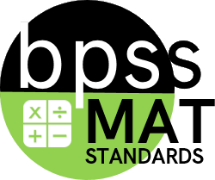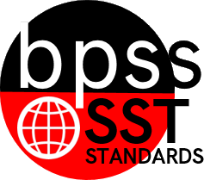BPS Curriculum
| Site: | Learnbps |
| Class: | (BPSS) Bismarck Public School Standards |
| Book: | BPS Curriculum |
| Printed by: | Guest user |
| Date: | Friday, December 19, 2025, 8:45 AM |
Elementary
Content
Kindergarten
K Grade
1st Grade
1st Grade
2nd Grade
2nd Grade
3rd Grade

Bismark Public Schools uses North Dakota Content Standards as a model to develop goals for teaching and learning and as expectations for what students should know and be able to do for each grade. Bismarck Public School district determines the curriculum (how standards are taught) we will adopt to meet the standards.
Note: Prioritized Standards Identifiers are auto-link to popup a detailed description with Proficiency Scales and other details.
 Third grade is a pivotal year for your child. Learning to read with fluency and confidence will serve as a foundation for the reading demands in later grades. By practicing with learning-to-read strategies, your child will reliably be able to
make sense of multisyllable words in books. He or she will come to appreciate that words have meanings that are not literal (e.g., a piece of cake) and have relationships to other words (e.g., company and companion). Recognizing and understanding
words will help your child read increasingly challenging stories and books and build knowledge about the world around him or her. By the end of the year, your child also will be writing clear sentences and paragraphs on a range of topics, drawing
on an expanding vocabulary.
Third grade is a pivotal year for your child. Learning to read with fluency and confidence will serve as a foundation for the reading demands in later grades. By practicing with learning-to-read strategies, your child will reliably be able to
make sense of multisyllable words in books. He or she will come to appreciate that words have meanings that are not literal (e.g., a piece of cake) and have relationships to other words (e.g., company and companion). Recognizing and understanding
words will help your child read increasingly challenging stories and books and build knowledge about the world around him or her. By the end of the year, your child also will be writing clear sentences and paragraphs on a range of topics, drawing
on an expanding vocabulary.
 ELA-03.RL Reading Literature Strand
ELA-03.RL Reading Literature Strand
- ELA-03.RL.01 Ask and answer questions to demonstrate understanding of a text, referring explicitly to the text as the basis for the answers.
- ELA-03.RL.02 Recount stories, including fables, folktales, and myths from diverse cultures to determine the central message, lesson, or moral and explain how it is conveyed through key details in the text.
 ELA-03.RI Reading Information Strand
ELA-03.RI Reading Information Strand
- ELA-03.RI.01 Ask and answer questions to demonstrate understanding of a text, referring explicitly to the text as the basis for the answers.
- ELA-03.RI.02 Determine the main idea of a text and recount the key details to explain how they support the main idea.
 ELA-03.RF Reading Foundational Skills Strand
ELA-03.RF Reading Foundational Skills Strand
(RF) Phonics and Word Recognition
- ELA-03.RF.03 Know and apply grade-level phonics and word analysis skills in decoding words.
- ELA-03.RF.04 Read with sufficient accuracy and fluency to support comprehension.
 ELA-03.W Writing Strand
ELA-03.W Writing Strand
- ELA-03.W.01 Write opinion pieces on familiar topics or texts, supporting a point of view with reasons.
- ELA-03.W.02 Write informative/explanatory texts to examine a topic and convey ideas and information clearly.
- ELA-03.W.03 Write narratives to develop real or imagined experiences or events using effective technique, descriptive details, and clear event sequences.
 ELA-03.L Language Strand
ELA-03.L Language Strand
- ELA-03.L.02 Demonstrate command of the conventions of standard English capitalization, punctuation, and spelling when writing.
 ELA-03.SL Speaking and Listening Strand
ELA-03.SL Speaking and Listening Strand
- ELA-03.SL.01 Engage effectively in a range of collaborative discussions, one-on-one, in groups, and teacher-led with diverse partners on grade 3 topics and texts, building on others' ideas and expressing their own clearly.
 In 3rd grade, your child will learn important new ideas and gain important new skills. One of the most important topics this year is multiplication and division. Another is fractions. Multiplication, division, and fractions are the building blocks
for many life skills that students will learn in later grades, such as percentages. Students also need to master these topics to be ready for algebra and advanced math, so it is essential to get a good start with these topics in 3rd grade.
In 3rd grade, your child will learn important new ideas and gain important new skills. One of the most important topics this year is multiplication and division. Another is fractions. Multiplication, division, and fractions are the building blocks
for many life skills that students will learn in later grades, such as percentages. Students also need to master these topics to be ready for algebra and advanced math, so it is essential to get a good start with these topics in 3rd grade.
MAT-03.OA Operations & Algebraic Thinking
- MAT-03.OA.03 Using drawings and equations with a symbol for an unknown number, solve multiplication and division word problems within 100 in situations involving equal groups, arrays, and measurement quantities.
- MAT-03.OA.07 Using mental strategies, fluently multiply and divide within 100
MAT-03.NF Number Fractions
- MAT-03.NF.03 - Explain equivalence of fractions in special cases, and compare fractions by reasoning about their size.
MAT-03.NBT Number & Operations in Base Ten
- MAT-03.NBT.02 Using strategies and algorithms based on place value, properties of operations, and/or the relationship between addition and subtraction, fluently add and subtract within 1000
MAT-03.MD Measurement & Data
- MAT-03.MD.01 Tell and Write time to the nearest minute and measure time intervals in minutes. solve elapsed time word problems on the hour and the half hour, using a variety of strategies.
- MAT-03.MD.03 Draw scaled picture graphs and scaled bar graphs to represent data sets with several categories. Solve one- and two-step how many more and how many less problems using information presented in scaled bar graphs.
- MAT-03.MD.08 Solve real world and mathematical problems involving perimeters of polygons, including finding the perimeter given the side lengths. Find an unknown side length. Exhibit rectangles with the same perimeter and different area or with the same area and different perimeters
MAT-03.G Geometry
- MAT-03.G.01 Understand that shapes in different categories may share attributes, and that the shared attributes can define a larger category. Recognize rhombuses, rectangles, and squares as examples of quadrilaterals. Draw examples of quadrilaterals that do not belong to any of these subcategories
 In third grade, students are expected to demonstrate grade-appropriate proficiency in asking questions and defining problems; developing and using models, planning and carrying out investigations, analyzing and interpreting data, constructing
explanations and designing solutions, engaging in argument from evidence, and obtaining, evaluating, and communicating information. Students are expected to use these practices to demonstrate understanding of the core ideas.
In third grade, students are expected to demonstrate grade-appropriate proficiency in asking questions and defining problems; developing and using models, planning and carrying out investigations, analyzing and interpreting data, constructing
explanations and designing solutions, engaging in argument from evidence, and obtaining, evaluating, and communicating information. Students are expected to use these practices to demonstrate understanding of the core ideas.
 SCI-03.LS1: Life Science (LS1)
SCI-03.LS1: Life Science (LS1)
From Molecules to Organisms: Structures and Processes
- SCI-03.LS1.01 Develop models to describe that organisms have unique and diverse life cycles but all experience birth, growth, reproduction, and death.
 SCI-03.LS3: Life Science (LS3)
SCI-03.LS3: Life Science (LS3)
Heredity: Inheritance and Variation of Trait
- SCI-03.LS3.02 Use evidence to support the explanation that the expression of traits can be influenced by the environment.
 SCI-03.LS4: Life Science (LS4)
SCI-03.LS4: Life Science (LS4)
Biological Evolution: Unity and Diversity
- SCI-03.LS4.03 Construct an argument with evidence that in a particular habitat some organisms can survive well, some survive less well, and some cannot survive at all.
 SCI-03.ESS2: Earth Science (ESS2)
SCI-03.ESS2: Earth Science (ESS2)
Earth's Systems
- SCI-03.ESS2.01 Represent data in tables and graphical displays to describe and predict typical weather conditions expected during a particular season.
 SCI-03.PS2: Physical Science (PS2)
SCI-03.PS2: Physical Science (PS2)
Motion and Stability: Forces and Interactions
- SCI-03.PS2.02 Make observations and metric measurements of an object's motion to prove that a pattern can be used to predict future motion
 A high-quality Social Studies program is essential for all students. It provides a foundation for intelligent and precise thinking. Social Studies should also prepare every student to contribute to society as an informed citizen. To be a responsible and productive member of today’s society, a student needs to have a broad, connected, and useful knowledge of Social Studies.
A high-quality Social Studies program is essential for all students. It provides a foundation for intelligent and precise thinking. Social Studies should also prepare every student to contribute to society as an informed citizen. To be a responsible and productive member of today’s society, a student needs to have a broad, connected, and useful knowledge of Social Studies.
 SST-03.C: Civics & Government (C)
SST-03.C: Civics & Government (C)
- SST-03.C.01 Compare and contrast the responsibilities and powers of government officials at various levels and branches of government.
- SST-03.C.02 Describe the structure of government and how it functions to serve citizens/residents.
- SST-03.C.05 Describe procedures for making decisions in a variety of settings.
- SST-03.C.06 Compare and contrast personal and civic responsibilities and explain why they are important in community life.
 SST-03.G: Geography (G)
SST-03.G: Geography (G)
- SST-03.G.01 Construct maps, graphs, and other representations of both familiar and unfamiliar places.
- SST-03.G.02 Use geographic tools and technologies to acquire, process and report information from a spatial perspectives.
 SST-03.E: Economics (E)
SST-03.E: Economics (E)
- SST-03.E.01 Utilize fundamental principles and concepts of economics to understand economic activity.
- SST-03.E.02 Describe how goods and services are produced and distributed.
- SST-03.E.03 Identify factors that influence saving and spending choices.
- SST-03.E.04 Describe the necessity and impact of community services.
 SST-03.H: History (H)
SST-03.H: History (H)
- SST-03.H.01 Compare and contrast multiple perspectives during the same time period, event, or historical period.
- SST-03.H.04 Analyze United States national holidays or days of observance and the impact on the culture of the United States.
4th Grade
4th Grade
5th Grade
5th Grade
Middle
Middle
6th Grade
6th Grade
7th Grade
7th Grade
8th Grade
8th Grade
Secondary
Secondary



